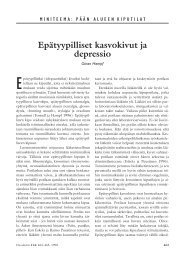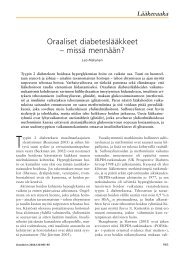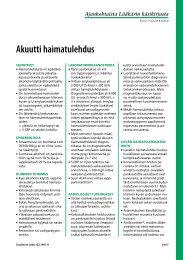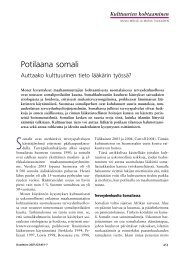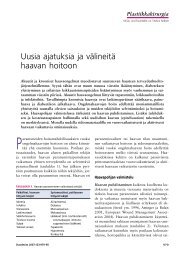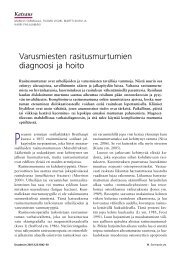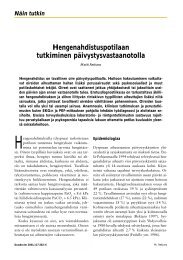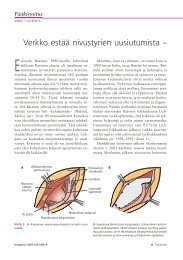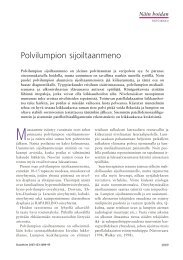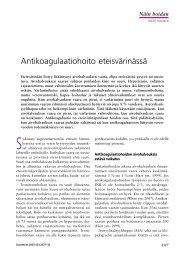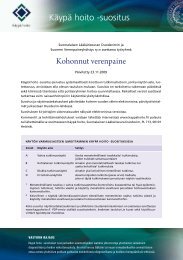Miksi letkuruokinta ei onnistu? - Duodecim
Miksi letkuruokinta ei onnistu? - Duodecim
Miksi letkuruokinta ei onnistu? - Duodecim
You also want an ePaper? Increase the reach of your titles
YUMPU automatically turns print PDFs into web optimized ePapers that Google loves.
Kirjallisuutta<br />
Adam S, Batson S. A study of problems associated with the delivery of<br />
enteral feed in critically ill patients in five ICUs in the UK. Intensive<br />
Care Med 1997;23:261–6.<br />
Basse L, Hjort Jakobsen D, Billesbolle P, ym. A clinical pathway to accelerate<br />
recovery after colonic resection. Ann Surg 2000;232(1):51–7.<br />
Beattie TK, Anderton A. Bacterial contamination of enteral feeding<br />
systems due to faulty handling procedures – a comparison of a<br />
new system with two established systems. J Human Nutr Dietics<br />
1998;11:313–21.<br />
Bengmark S. Progress in perioperative enteral tube feeding. Clin Nutr<br />
1998;17:145–52.<br />
Benya R, Damle P, Mobarhan S. Diarrhea complicating enteral feeding<br />
after liver transplantation. Nutr Rev 1990;48(3):148–52.<br />
Braga M, Bozzetti F, Dionigi P. Parenteral and enteral feeding in hospitals<br />
in Italy: a national survey. Clin Nutr 1994;13:153–60.<br />
Braga M, Gianotti L, Vignali A, ym. Artificial nutrition after major abdominal<br />
surgery: impact of route of administration and composition<br />
of the diet. Crit Care Med 1998;26:24–30.<br />
Brinson RR, Kolts BE. Hypoalbuminemia as an indicator of diarrheal<br />
incidence in critically ill patients. Crit Care Med 1987;15(5):506–9.<br />
Bruun LI, Bosaeus I, Bergstad I, Nygaard K. Prevalence of malnutrition in<br />
surgical patients: evaluation of nutritional support and documentation.<br />
Clin Nutr 1999;18:141–7.<br />
Castrén M, Mäkeläinen A. Enteraalinen ravitsemus. <strong>Duodecim</strong> 1999;115:<br />
583–94.<br />
Cresci GA, Moore J, Martindale RG. Do critically ill patients rec<strong>ei</strong>ve prescribed<br />
and adequate nutrition intervention? Clin Nutr 1999;<br />
18(S1):167.<br />
Guenter PA, Settle RG, Perlmutter S, ym. Tube feeding-related diarrhea<br />
in acutely ill patients. JPEN 1991;15(3):277–80.<br />
Demetriades H, Botsios D, Kazantzidou D, ym. Effect of early postoperative<br />
enteral feeding on the healing of colonic anastomoses in<br />
rats. Comparison of three different enteral diets. Eur Surg Res<br />
1999;31(1):57–63.<br />
Duggan C, Nurko S. »Feeding the gut»: The scientific basis for continued<br />
enteral nutrition during acute diarrhea. J Pediatr 1997;131:<br />
801–8.<br />
Edington J, Boorman J, Durrant ER, ym. Prevalence of malnutrition on<br />
admission to four hospitals in England. Clin Nutr 2000;19(3):191–<br />
5.<br />
Hamvas J, Pap A. The role of jejunal feeding in the treatment of acute<br />
necrotizing pancreatitis and in recurrence of chronic pancreatitis<br />
with severe necrosis. Orv Hetil 1998;139(16):945–9.<br />
H<strong>ei</strong>mburger DC, Sockwell DG, Geels WJ. Diarrhea with enteral feeding:<br />
prospective reappraisal of putative causes. Nutrition 1994;10(5):<br />
329–36.<br />
Homann HH, Kemen M, Fuessenich C, ym. Reduction in diarrhea incidence<br />
by soluble fiber in patients rec<strong>ei</strong>ving total or supplemental<br />
enteral nutrition. JPEN 1994;18(6):486–90.<br />
Kandil HE, Oper FH, Switzer BR, H<strong>ei</strong>tzer WD. Marked resistance of normal<br />
subjects to tube-feeding-induced diarrhea: the role of magnesium.<br />
Am J Clin Nutr 1993;57:73–80.<br />
McClave SA, Sexton LK, Spain DA, ym. Enteral tube feeding in the<br />
intensive care unit: factors impeding adequate delivery. Crit Care<br />
Med 1999;27:1252–6.<br />
McWhirter JP, Pennington CR. Incidence and recognition of malnutrition<br />
in hospital. BMJ 1994;308:945–8.<br />
Metheny N. Preventing pulmonary complications during enteral feeding<br />
in the critically ill. Program manual Aspen 18th Clinical Congress,<br />
Jan 30 – Feb 2, 1994;318–22.<br />
Montejo JC. Enteral nutrition-related gastrointestinal complications in<br />
critically ill patients: a multicenter study. Crit Care Med 1999;<br />
27(8):1447–53.<br />
Nuutinen L, Alahuhta S. Tehostetun ravitsemushoidon ravitsemussuunnitelma.<br />
<strong>Duodecim</strong> 1999;115:574–82.<br />
Patchell CJ, Anderton A, Holeden C, ym. Reducing bacterial contamination<br />
of enteral feeds. Arch Dis Child 1998;78:166–8.<br />
Payne-James JJ, Rana SK, Bray MJ, ym. Retrograde (ascending) bacterial<br />
contamination of enteral diet administration systems. JPEN<br />
1992;16(4):369–73.<br />
Raff T, German T, Hartmann B. The value of early enteral nutrition in<br />
the profylaksis of stress ulceration in the severely burned patient.<br />
Burns 1997;23:313–8.<br />
Rollins H. Tube Feeding-luento. 22nd Espen Congress 9.–13. syyskuuta<br />
2000.<br />
Sch<strong>ei</strong>nin B, Asantila R, Orko R. The effect of bupivacaine and morphine<br />
on pain and bowel function after colonic surgery. Acta Anesthesiol<br />
Scand 1987;31:161–4.<br />
Singh G, Ram RP, Khanna SK. Early postoperative enteral feeding in<br />
patients with nontraumatic intestinal perforation and peritonitis.<br />
J Am Coll Surg 1998;187(2):142–6.<br />
Taylor SJ, Fettes SB, Jewkes C, ym. Prospective, randomized, controlled<br />
trial to determine the effect of early enhanced enteral nutrition<br />
on clinical outcome in mechanically ventilated patients suffering<br />
head injury. Crit Care Med 1999;21(11):2525–31.<br />
Mitä opin<br />
MAARET CASTRÉN, LT, osastonlääkäri<br />
m.castren@kolumbus.fi<br />
HUS:n ensihoitoyksikkö<br />
Agricolankatu 15<br />
00530 Helsinki<br />
1. Mitkä seuraavista taud<strong>ei</strong>sta ovat enteraalisen<br />
ravitsemuksen aloituksen indikaatioita?<br />
a) Vaikea palovamma<br />
b) Vaikea haimatulehdus<br />
c) Peritoniitti<br />
d) Vaikea kallovamma<br />
2. Enteraalisesti ravittu potilas saa tarvitsemastaan<br />
energiamäärästä käytännössä keskimäärin<br />
a) 80 %<br />
b) 70 %<br />
c) 60 %<br />
d) 50 %<br />
3. Letkuruokintapotilailla suolen peristaltiikkaa<br />
parantaa<br />
a) Dopamiini<br />
b) Epiduraalipuudutus<br />
c) Metoklopramidi<br />
d) Tehokas kivunlievitys opiaat<strong>ei</strong>lla<br />
4. Enteraalinen ravitsemus tulee keskeyttää, jos<br />
a) Potilaalle tehdään haavarevisio<br />
b) Potilaalle tulee ripuli<br />
c) Residuaali on 200 ml nenämahaletkusta<br />
aspiroitaessa<br />
d) Suoliäänet <strong>ei</strong>vät kuulu<br />
5. Enteraalinen ravitsemus toteutuu parhaiten, jos<br />
a) Hoitosuunnitelma on olemassa ja sitä noudatetaan<br />
b) Hoitohenkilökunnan tietoa ravitsemuksesta<br />
lisätään koulutuksella<br />
c) Se aloitetaan vasta muutaman vuorokauden<br />
kuluttua sairastumisesta<br />
d) Ravintoa annetaan jatkuvana infuusiona<br />
Oikeat vastaukset sivulla 1260<br />
<strong>Miksi</strong> <strong>letkuruokinta</strong> <strong>ei</strong> <strong>onnistu</strong>?<br />
1239



